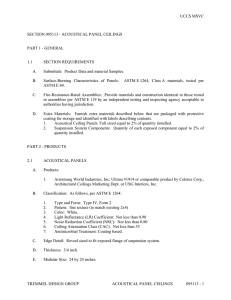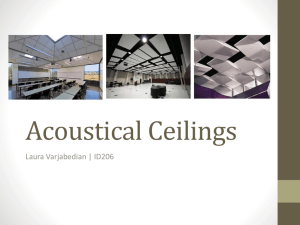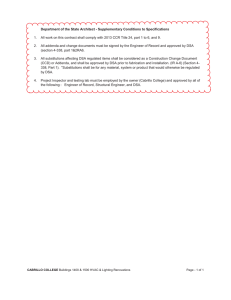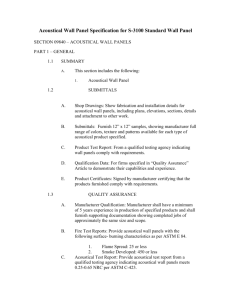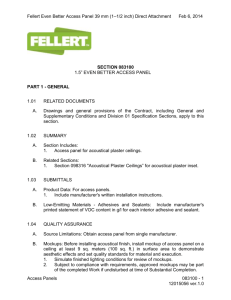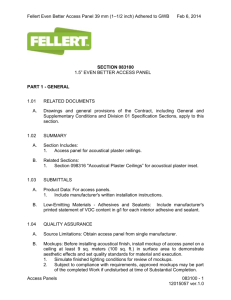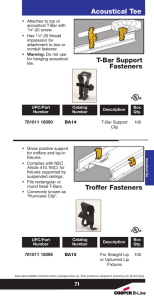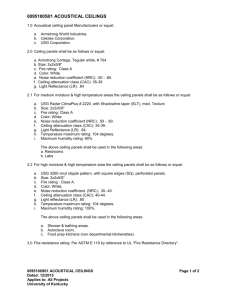SECTION 09 51 13 - ACOUSTICAL PANEL CEILINGS 1.1 RELATED DOCUMENTS
advertisement
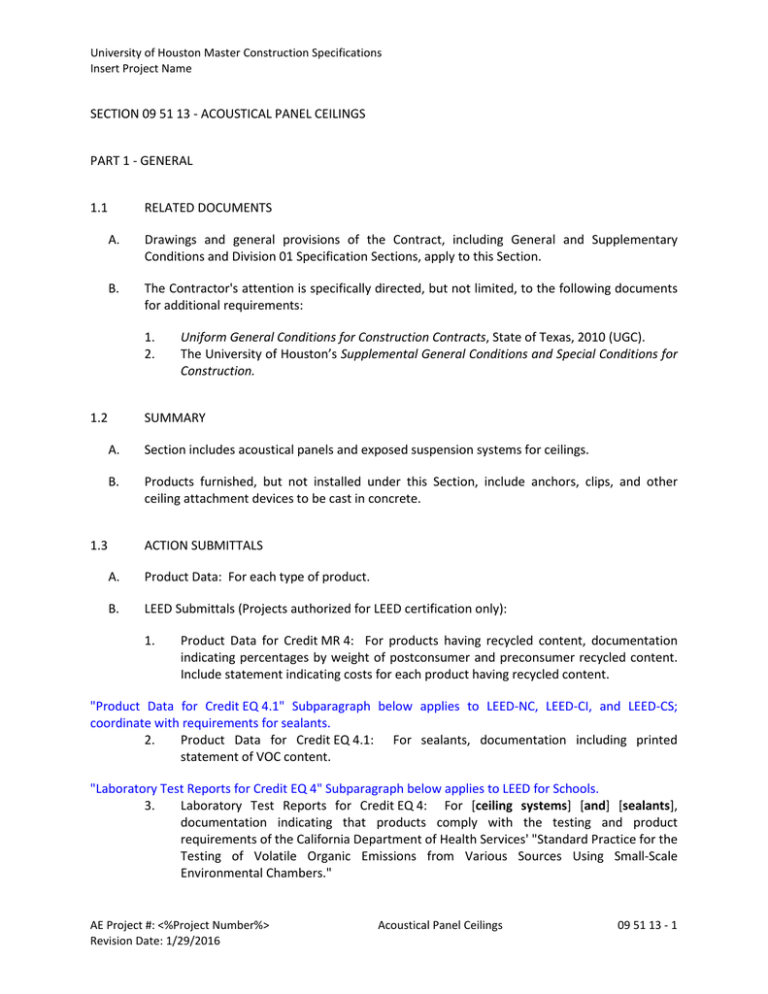
University of Houston Master Construction Specifications Insert Project Name SECTION 09 51 13 - ACOUSTICAL PANEL CEILINGS PART 1 - GENERAL 1.1 RELATED DOCUMENTS A. Drawings and general provisions of the Contract, including General and Supplementary Conditions and Division 01 Specification Sections, apply to this Section. B. The Contractor's attention is specifically directed, but not limited, to the following documents for additional requirements: 1. 2. 1.2 Uniform General Conditions for Construction Contracts, State of Texas, 2010 (UGC). The University of Houston’s Supplemental General Conditions and Special Conditions for Construction. SUMMARY A. Section includes acoustical panels and exposed suspension systems for ceilings. B. Products furnished, but not installed under this Section, include anchors, clips, and other ceiling attachment devices to be cast in concrete. 1.3 ACTION SUBMITTALS A. Product Data: For each type of product. B. LEED Submittals (Projects authorized for LEED certification only): 1. Product Data for Credit MR 4: For products having recycled content, documentation indicating percentages by weight of postconsumer and preconsumer recycled content. Include statement indicating costs for each product having recycled content. "Product Data for Credit EQ 4.1" Subparagraph below applies to LEED-NC, LEED-CI, and LEED-CS; coordinate with requirements for sealants. 2. Product Data for Credit EQ 4.1: For sealants, documentation including printed statement of VOC content. "Laboratory Test Reports for Credit EQ 4" Subparagraph below applies to LEED for Schools. 3. Laboratory Test Reports for Credit EQ 4: For [ceiling systems] [and] [sealants], documentation indicating that products comply with the testing and product requirements of the California Department of Health Services' "Standard Practice for the Testing of Volatile Organic Emissions from Various Sources Using Small-Scale Environmental Chambers." AE Project #: <%Project Number%> Revision Date: 1/29/2016 Acoustical Panel Ceilings 09 51 13 - 1 University of Houston Master Construction Specifications Insert Project Name Retain "Samples" Paragraph below for single-stage Samples, with a subordinate list if applicable. Retain "Samples for Initial Selection" and "Samples for Verification" paragraphs for two-stage Samples. C. Samples: For each exposed product and for each color and texture specified, 6 inches in size. D. Samples for Initial Selection: For components with factory-applied color finishes. E. Samples for Verification: For each component indicated and for each exposed finish required, prepared on Samples of size indicated below. 1. 2. 1.4 Acoustical Panel: Set of 6-inch- square Samples of each type, color, pattern, and texture. Exposed Suspension-System Members, Moldings, and Trim: Set of 6-inch- long Samples of each type, finish, and color. INFORMATIONAL SUBMITTALS A. Coordination Drawings: Reflected ceiling plans, drawn to scale, on which the following items are shown and coordinated with each other, using input from installers of the items involved: 1. 2. 3. Suspended ceiling components. Structural members to which suspension systems will be attached. Items penetrating finished ceiling including the following: a. b. c. d. 4. Lighting fixtures. Air outlets and inlets. Speakers. Sprinklers. Perimeter moldings. B. Qualification Data: For testing agency. C. Product Test Reports: For each acoustical panel ceiling, for tests performed by a qualified testing agency. D. Evaluation Reports: For each acoustical panel ceiling suspension system and anchor and fastener type, from ICC-ES. E. Field quality-control reports. 1.5 CLOSEOUT SUBMITTALS A. Maintenance Data: For finishes to include in maintenance manuals. AE Project #: <%Project Number%> Revision Date: 1/29/2016 Acoustical Panel Ceilings 09 51 13 - 2 University of Houston Master Construction Specifications Insert Project Name 1.6 MAINTENANCE MATERIAL SUBMITTALS A. Furnish extra materials that match products installed and that are packaged with protective covering for storage and identified with labels describing contents. 1. 2. 3. 4. 1.7 Acoustical Ceiling Panels: Full-size panels equal to 5 percent of quantity installed, rounded to the nearest full box. Suspension-System Components: Quantity of each exposed component equal to 5 percent of quantity installed. Hold-Down Clips: Equal to 5 percent of quantity installed. Impact Clips: Equal to 5 percent of quantity installed. DELIVERY, STORAGE, AND HANDLING A. Deliver acoustical panels, suspension-system components, and accessories to Project site in original, unopened packages and store them in a fully enclosed, conditioned space where they will be protected against damage from moisture, humidity, temperature extremes, direct sunlight, surface contamination, and other causes. B. Before installing acoustical panels, permit them to reach room temperature and a stabilized moisture content. C. Handle acoustical panels carefully to avoid chipping edges or damaging units in any way. 1.8 FIELD CONDITIONS A. Environmental Limitations: Do not install acoustical panel ceilings until spaces are enclosed and weatherproof, wet work in spaces is complete and dry, work above ceilings is complete, and ambient temperature and humidity conditions are maintained at the levels indicated for Project when occupied for its intended use. PART 2 - PRODUCTS 2.1 PERFORMANCE REQUIREMENTS A. Surface-Burning Characteristics: Comply with ASTM E 84; testing by a qualified testing agency. Identify products with appropriate markings of applicable testing agency. 1. 2. Flame-Spread Index: Comply with ASTM E 1264 for Class A materials. Smoke-Developed Index: 50 or less. Retain "Fire-Resistance Ratings" Paragraph below only if products specified are part of a fire-resistancerated assembly. Indicate rating, testing agency, and testing agency's design designation on Drawings. B. Fire-Resistance Ratings: Comply with ASTM E 119; testing by a qualified testing agency. Identify products with appropriate markings of applicable testing agency. AE Project #: <%Project Number%> Revision Date: 1/29/2016 Acoustical Panel Ceilings 09 51 13 - 3 University of Houston Master Construction Specifications Insert Project Name 1. 2.2 Indicate design designations from UL's "Fire Resistance Directory" or from the listings of another qualified testing agency. ACOUSTICAL PANELS, GENERAL A. Low-Emitting Materials: Acoustical panel ceilings shall comply with the testing and product requirements of the California Department of Health Services' "Standard Practice for the Testing of Volatile Organic Emissions from Various Sources Using Small-Scale Environmental Chambers." B. Source Limitations: 1. 2. Acoustical Ceiling Panel: Obtain each type from single source from single manufacturer. Suspension System: Obtain each type from single source from single manufacturer. Retain "Recycled Content" Paragraph below to specify recycled content if applying for LEED Credit MR 4. C. Recycled Content: Postconsumer recycled content plus one-half of preconsumer recycled content not less than 50 percent. D. Glass-Fiber-Based Panels: Made with binder containing no urea formaldehyde. E. Acoustical Panel Standard: Provide manufacturer's standard panels of configuration indicated that comply with ASTM E 1264 classifications as designated by types, patterns, acoustical ratings, and light reflectances unless otherwise indicated. 1. F. 2.3 Mounting Method for Measuring NRC: Type E-400; plenum mounting in which face of test specimen is 15-3/4 inches away from test surface according to ASTM E 795. Acoustical Panel Colors and Patterns: Match appearance characteristics indicated for each product type. ACOUSTICAL PANELS ACT-1 A. Basis-of-Design Product: Subject to compliance with requirements, provide Armstrong World Industries, Inc. Ultima Open Plan, Item 1942, or comparable product by one of the following: 1. CertainTeed Corp. 2. USG Interiors, Inc.; Subsidiary of USG Corporation. 3. See section 01 25 00 – substitution Procedures. Do not assume that every combination of fire-resistance rating, classification, pattern, color, light reflectance, acoustical rating, edge detail, thickness, and size listed under each product description is available. Before retaining salient characteristics, verify availability with manufacturers. Retain option in "Classification" Paragraph below along with permitted fire-resistance-rated suspension system if fire-rated assembly is required for Project. Indicate rating, testing agency, and testing agency's design designation on Drawings. AE Project #: <%Project Number%> Revision Date: 1/29/2016 Acoustical Panel Ceilings 09 51 13 - 4 University of Houston Master Construction Specifications Insert Project Name B. Classification: Provide[ fire-resistance-rated] panels complying with ASTM E 1264 for type, form, and pattern as follows: 1. Type and Form: Type IV, mineral fiber base with membrane-faced overlay; Form 2, cloth. 2. Pattern: E (lightly textured). C. Color: White. D. LR: Not less than E. NRC: Not less than F. CAC: Not less than 35. G. AC: Not less than 170. H. Edge/Joint Detail: Reveal sized to fit flange of exposed suspension-system members. I. Thickness: J. Modular Size: 24 by 24 inches. K. Broad Spectrum Antimicrobial Fungicide and Bactericide Treatment: Provide acoustical panels treated with manufacturer's standard antimicrobial formulation that inhibits fungus, mold, mildew, and gram-positive and gram-negative bacteria and showing no mold, mildew, or bacterial growth when tested according to ASTM D 3273 and evaluated according to ASTM D 3274 or ASTM G 21. 2.4 0.89 . 0.75. 3/4 inch. ACOUSTICAL PANELS ACT-2 A. Basis-of-Design Product: Subject to compliance with requirements, provide Armstrong World Industries, Inc. Optima Open Plan, Item 3355, or comparable product by one of the following: 1. CertainTeed Corp. 2. USG Interiors, Inc.; Subsidiary of USG Corporation. 3. See section 01 25 00 – substitution Procedures. Do not assume that every combination of fire-resistance rating, classification, pattern, color, light reflectance, acoustical rating, edge detail, thickness, and size listed under each product description is available. Before retaining salient characteristics, verify availability with manufacturers. Retain option in "Classification" Paragraph below along with permitted fire-resistance-rated suspension system if fire-rated assembly is required for Project. Indicate rating, testing agency, and testing agency's design designation on Drawings. B. Classification: Provide[ fire-resistance-rated] panels complying with ASTM E 1264 for type, form, and pattern as follows: 1. Type and Form: Type XII, glass-fiber base with membrane-faced overlay; Form 2, cloth . 2. Pattern: E (lightly textured). AE Project #: <%Project Number%> Revision Date: 1/29/2016 Acoustical Panel Ceilings 09 51 13 - 5 University of Houston Master Construction Specifications Insert Project Name C. Color: White. D. LR: Not less than E. NRC: Not less than F. CAC: Not less than 25. G. AC: Not less than 200. H. Edge/Joint Detail: Reveal sized to fit flange of exposed suspension-system members. I. Thickness: J. Modular Size: 24 by 24 inches. K. Broad Spectrum Antimicrobial Fungicide and Bactericide Treatment: Provide acoustical panels treated with manufacturer's standard antimicrobial formulation that inhibits fungus, mold, mildew, and gram-positive and gram-negative bacteria and showing no mold, mildew, or bacterial growth when tested according to ASTM D 3273 and evaluated according to ASTM D 3274 or ASTM G 21. 2.5 0.90. 0.90. 1 inch. ACOUSTICAL PANELS ACT-3 A. Basis-of-Design Product: Subject to compliance with requirements, provide Armstrong World Industries, Inc. Cortega UH Pattern, or comparable product by one of the following: 1. 2. 3. CertainTeed Corp. USG Interiors, Inc.; Subsidiary of USG Corporation. Substitutions: See Section 01 25 00 – Substitution Procedures. Retain option in "Classification" Paragraph below along with permitted fire-resistance-rated suspension system if fire-rated assembly is required for Project. Indicate rating, testing agency, and testing agency's design designation on Drawings. B. Classification: Provide[ fire-resistance-rated] panels complying with ASTM E 1264 for type, form, and pattern as follows: 1. 2. Type and Form: Type III, mineral base with painted finish; Form 2, water felted. Pattern: CD (perforated, small holes and fissured). C. Color: White. D. LR: Not less than 0.82. E. NRC: Not less than 0.55. F. CAC: Not less than 33. AE Project #: <%Project Number%> Revision Date: 1/29/2016 Acoustical Panel Ceilings 09 51 13 - 6 University of Houston Master Construction Specifications Insert Project Name G. Edge/Joint Detail: Reveal sized to fit flange of exposed suspension-system members. Retain one of two "Thickness" paragraphs below. H. Thickness: 5/8 inch. I. Modular Size: 24 by 24 inches. J. Broad Spectrum Antimicrobial Fungicide and Bactericide Treatment: Provide acoustical panels treated with manufacturer's standard antimicrobial formulation that inhibits fungus, mold, mildew, and gram-positive and gram-negative bacteria and showing no mold, mildew, or bacterial growth when tested according to ASTM D 3273 and evaluated according to ASTM D 3274 or ASTM G 21. 2.6 METAL SUSPENSION SYSTEMS, GENERAL A. Recycled Content: Postconsumer recycled content plus one-half of preconsumer recycled content not less than 25 percent. B. Metal Suspension-System Standard: Provide manufacturer's standard direct-hung metal suspension systems of types, structural classifications, and finishes indicated that comply with applicable requirements in ASTM C 635/C 635M. Retain "High-Humidity Finish" Subparagraph below if required. Finish is generally applicable to hot-dip galvanized steel with G60 (Z180) or greater coating and aluminum systems with anodized finish. ASTM C 635/C 635M requires salt-spray testing and high-humidity testing. On Drawings, show where high-humidity finishes are required. 1. C. High-Humidity Finish: Comply with ASTM C 635/C 635M requirements for "Coating Classification for Severe Environment Performance" where high-humidity finishes are indicated. Attachment Devices: Size for five times the design load indicated in ASTM C 635/C 635M, Table 1, "Direct Hung," unless otherwise indicated. "Anchors in Concrete" Subparagraph below does not apply to power-actuated fasteners. Delete if no anchorage to concrete is required or if power-actuated fasteners are acceptable. Verify safety factor with Project's structural engineer. Revise testing methods below if required by authorities having jurisdiction. 1. Anchors in Concrete: Anchors of type and material indicated below, with holes or loops for attaching hangers of type indicated and with capability to sustain, without failure, a load equal to [five] <Insert safety factor> times that imposed by ceiling construction, as determined by testing according to ASTM E 488 or ASTM E 1512 as applicable, conducted by a qualified testing and inspecting agency. Retain an option in "Type" Subparagraph below; verify suitability with Project's structural engineer. AE Project #: <%Project Number%> Revision Date: 1/29/2016 Acoustical Panel Ceilings 09 51 13 - 7 University of Houston Master Construction Specifications Insert Project Name a. Type: [Cast-in-place] [Postinstalled expansion] [Postinstalled bonded] anchors. Retain one of three "Corrosion Protection" subparagraphs below or, if more than one is required, indicate by inserting location of each on Drawings. Zinc plating of mild class indicated protects against corrosion from an indoor atmosphere with rare condensation and subject to minimum wear or abrasion; revise thickness to suit more corrosive conditions or use stainless steel or nickel-copper alloy, depending on conditions. If postinstalled expansion anchors are used to attach nickel-copper-alloy wire hangers and braces, consider retaining nickel-copper anchors after verifying availability with manufacturers. b. c. d. Corrosion Protection: Carbon-steel components zinc plated to comply with ASTM B 633, Class Fe/Zn 5 (0.005 mm) for Class SC 1 service condition. Corrosion Protection: Stainless-steel components complying with ASTM F 593 and ASTM F 594, Group 1 Alloy 304 or 316 for bolts; Alloy 304 or 316 for anchor. Corrosion Protection: Components fabricated from nickel-copper-alloy rods complying with ASTM B 164 for UNS No. N04400 alloy. Retain "Power-Actuated Fasteners in Concrete" Subparagraph below if power-actuated fasteners are allowed. Verify safety factor with Project's structural engineer. 2. D. Power-Actuated Fasteners in Concrete: Fastener system of type suitable for application indicated, fabricated from corrosion-resistant materials, with clips or other accessory devices for attaching hangers of type indicated and with capability to sustain, without failure, a load equal to [10] <Insert safety factor> times that imposed by ceiling construction, as determined by testing according to ASTM E 1190, conducted by a qualified testing and inspecting agency. Wire Hangers, Braces, and Ties: Provide wires complying with the following requirements: Retain one of "Zinc-Coated, Carbon-Steel Wire," "Stainless-Steel Wire," or "Nickel-Copper-Alloy Wire" subparagraphs below unless more than one type of wire is required. If more than one type of wire is required, indicate location of each on Drawings. See Evaluations for discussion on corrosion resistance of hangers and fasteners. Revise hangers to strap type if required by authorities having jurisdiction or by local union regulations. 1. 2. 3. Zinc-Coated, Carbon-Steel Wire: ASTM A 641/A 641M, Class 1 zinc coating, soft temper. Stainless-Steel Wire: ASTM A 580/A 580M, Type 304, nonmagnetic. Nickel-Copper-Alloy Wire: ASTM B 164, nickel-copper-alloy UNS No. N04400. Retain second option in "Size" Subparagraph below if required by authorities having jurisdiction or if desired for extra security and quality (including corrosion allowance). Because large sizes are difficult to work with, their use could result in poor leveling tolerance. 4. E. Size: Select wire diameter so its stress at three times hanger design load (ASTM C 635/C 635M, Table 1, "Direct Hung") will be less than yield stress of wire, but provide not less than [0.106-inch-] [0.135-inch-] <Insert dimension> diameter wire. Stabilizer Bars: lateral forces. Manufacturer's standard perimeter stabilizers designed to accommodate AE Project #: <%Project Number%> Revision Date: 1/29/2016 Acoustical Panel Ceilings 09 51 13 - 8 University of Houston Master Construction Specifications Insert Project Name F. Hold-Down Clips: Where indicated, provide manufacturer's standard hold-down clips spaced 24 inches o.c. on all cross tees. Retain "Impact Clips" Paragraph below if required. Indicate location on Drawings or by inserts. G. Impact Clips: Where indicated, provide manufacturer's standard impact-clip system designed to absorb impact forces against acoustical panels. Retain "Clean-Room Gasket System" Paragraph below if required. Verify, with manufacturers, product availability and compatibility of gasket type with panels and suspension system specified. Indicate location on Drawings or by inserts. H. 2.7 Clean-Room Gasket System: Where indicated, provide manufacturer's standard system, including [manufacturer's standard] [closed-cell PVC] [neoprene] [antimicrobial] gasket and related adhesives, tapes, seals, and retention clips, designed to seal out foreign material from and maintain positive pressure in clean room. METAL SUSPENSION SYSTEM Type 1 A. Basis-of-Design Product: Subject to compliance with requirements, provide Armstrong World Industries, Inc. Silhouette XL 1/8” Reveal, or comparable product by one of the following: 1. CertainTeed Corp. 2. USG Interiors, Inc.; Subsidiary of USG Corporation. 3. Substitutions: See Section 01 25 00 – Substitution Procedures.. B. Narrow-Face, Capped, Double-Web, Steel Suspension System: Main and cross runners roll formed from cold-rolled steel sheet; prepainted, electrolytically zinc coated, or hot-dip galvanized according to ASTM A 653/A 653M, not less than G30 coating designation; with prefinished 9/16-inch- wide metal caps on flanges. 1. 2. 3. 4. 5. 2.8 Structural Classification: Heavy-duty system. End Condition of Cross Runners: butt-edge type. Face Design: Flanges formed with an integral center reveal. Cap Material: Steel cold-rolled sheet. Cap Finish: Painted white . METAL SUSPENSION SYSTEM Type 2 A. Basis-of-Design Product: Subject to compliance with requirements, provide Armstrong World Industries, Inc. Suprafine XL, or comparable product by one of the following: 1. 2. 3. B. CertainTeed Corp. USG Interiors, Inc.; Subsidiary of USG Corporation. Substitutions: See Section 01 25 00 – Substitution Procedures.. Narrow-Face, Capped, Double-Web, Steel Suspension System: Main and cross runners roll formed from cold-rolled steel sheet; prepainted, electrolytically zinc coated, or hot-dip AE Project #: <%Project Number%> Revision Date: 1/29/2016 Acoustical Panel Ceilings 09 51 13 - 9 University of Houston Master Construction Specifications Insert Project Name galvanized according to ASTM A 653/A 653M, not less than G30 coating designation; with prefinished 9/16-inch- wide metal caps on flanges. 1. 2. 3. 4. 5. 2.9 Structural Classification: Heavy-duty system. End Condition of Cross Runners: butt-edge type. Face Design: Flat, flush. Cap Material: Steel cold-rolled sheet. Cap Finish: Painted white . METAL EDGE MOLDINGS AND TRIM Retain "Manufacturers" Paragraph and list of manufacturers below to require products from manufacturers listed or a comparable product from other manufacturers. A. Manufacturers: Subject to compliance with requirements, provide products by one of the following : 1. 2. 3. 4. B. Roll-Formed, Sheet-Metal Edge Moldings and Trim: Type and profile indicated or, if not indicated, manufacturer's standard moldings for edges and penetrations; formed from sheet metal of same material, finish, and color as that used for exposed flanges of suspensionsystem runners. 1. 2. 3. 2.10 A. Armstrong World Industries, Inc. CertainTeed Corp. USG Interiors, Inc.; Subsidiary of USG Corporation. Substitutions: See Section 01 25 00 – Substitution Procedures. Provide manufacturer's standard edge moldings that fit acoustical panel edge details and suspension systems indicated and that match width and configuration of exposed runners unless otherwise indicated. For lay-in panels with reveal edge details, provide stepped edge molding that forms reveal of same depth and width as that formed between edge of panel and flange at exposed suspension member . For circular penetrations of ceiling, provide edge moldings fabricated to diameter required to fit penetration exactly. ACOUSTICAL SEALANT Products: Subject to compliance with requirements, available products that may be incorporated into the Work include, but are not limited to, the following: 1. Acoustical Sealant for Exposed and Concealed Joints: a. b. 2. Pecora Corporation; AC-20 FTR Acoustical and Insulation Sealant. USG Corporation; SHEETROCK Acoustical Sealant. Acoustical Sealant for Concealed Joints: AE Project #: <%Project Number%> Revision Date: 1/29/2016 Acoustical Panel Ceilings 09 51 13 - 10 University of Houston Master Construction Specifications Insert Project Name a. b. c. B. Henkel Corporation; OSI Pro-Series SC-175 Acoustical Sound Sealant. Pecora Corporation; AIS-919. Tremco, Inc.; Tremco Acoustical Sealant. Acoustical Sealant: Manufacturer's standard sealant complying with ASTM C 834 and effective in reducing airborne sound transmission through perimeter joints and openings in building construction as demonstrated by testing representative assemblies according to ASTM E 90. 1. 2. 3. Exposed and Concealed Joints: Nonsag, paintable, nonstaining latex sealant. Concealed Joints: Nondrying, nonhardening, nonskinning, nonstaining, gunnable, synthetic-rubber sealant. Acoustical sealant shall have a VOC content of 250 g/L or less when calculated according to 40 CFR 59, Subpart D (EPA Method 24). PART 3 - EXECUTION 3.1 EXAMINATION A. Examine substrates, areas, and conditions, including structural framing to which acoustical panel ceilings attach or abut, with Installer present, for compliance with requirements specified in this and other Sections that affect ceiling installation and anchorage and with requirements for installation tolerances and other conditions affecting performance of acoustical panel ceilings. B. Examine acoustical panels before installation. Reject acoustical panels that are wet, moisture damaged, or mold damaged. C. Proceed with installation only after unsatisfactory conditions have been corrected. 3.2 PREPARATION A. 3.3 Measure each ceiling area and establish layout of acoustical panels to balance border widths at opposite edges of each ceiling. Avoid using less-than-half-width panels at borders, and comply with layout shown on reflected ceiling plans. INSTALLATION A. General: Install acoustical panel ceilings to comply with ASTM C 636/C 636M , according to manufacturer's written instructions and CISCA's "Ceiling Systems Handbook." Retain "Fire-Rated Assembly" Subparagraph below if applicable. 1. B. Fire-Rated Assembly: Install fire-rated ceiling systems according to tested fire-rated design. Suspend ceiling hangers from building's structural members and as follows: AE Project #: <%Project Number%> Revision Date: 1/29/2016 Acoustical Panel Ceilings 09 51 13 - 11 University of Houston Master Construction Specifications Insert Project Name 1. Install hangers plumb and free from contact with insulation or other objects within ceiling plenum that are not part of supporting structure or of ceiling suspension system. Retain option in first subparagraph below only if fire-resistance-rated ceilings are retained. 2. 3. 4. 5. 6. 7. Splay hangers only where required [ and, if permitted with fire-resistance-rated ceilings,] to miss obstructions; offset resulting horizontal forces by bracing, countersplaying, or other equally effective means. Where width of ducts and other construction within ceiling plenum produces hanger spacings that interfere with location of hangers at spacings required to support standard suspension-system members, install supplemental suspension members and hangers in form of trapezes or equivalent devices. Secure wire hangers to ceiling-suspension members and to supports above with a minimum of three tight turns. Connect hangers directly either to structures or to inserts, eye screws, or other devices that are secure and appropriate for substrate and that will not deteriorate or otherwise fail due to age, corrosion, or elevated temperatures. Do not support ceilings directly from permanent metal forms or floor deck. Fasten hangers to cast-in-place hanger inserts, postinstalled mechanical or adhesive anchors, or power-actuated fasteners that extend through forms into concrete. When steel framing does not permit installation of hanger wires at spacing required, install carrying channels or other supplemental support for attachment of hanger wires. Do not attach hangers to steel deck tabs. Retain first subparagraph below unless attaching to the roof deck is permitted by the structural engineer and authorities having jurisdiction. Revise if structural members are spaced too far apart for hangers and another method is required. For alternatives that may need to be detailed on Drawings, consult structural engineer and see CISCA's guidelines. 8. 9. 10. Do not attach hangers to steel roof deck. Attach hangers to structural members. Space hangers not more than 48 inches o.c. along each member supported directly from hangers unless otherwise indicated; provide hangers not more than 8 inches from ends of each member. Size supplemental suspension members and hangers to support ceiling loads within performance limits established by referenced standards and publications. C. Secure bracing wires to ceiling suspension members and to supports with a minimum of four tight turns. Suspend bracing from building's structural members as required for hangers, without attaching to permanent metal forms, steel deck, or steel deck tabs. Fasten bracing wires into concrete with cast-in-place or postinstalled anchors. D. Install edge moldings and trim of type indicated at perimeter of acoustical ceiling area and where necessary to conceal edges of acoustical panels. 1. 2. Apply acoustical sealant where required on drawings in a continuous ribbon concealed on back of vertical legs of moldings before they are installed. Screw attach moldings to substrate at intervals not more than 16 inches o.c. and not more than 3 inches from ends, leveling with ceiling suspension system to a tolerance of 1/8 inch in 12 feet. Miter corners accurately and connect securely. AE Project #: <%Project Number%> Revision Date: 1/29/2016 Acoustical Panel Ceilings 09 51 13 - 12 University of Houston Master Construction Specifications Insert Project Name 3. Do not use exposed fasteners, including pop rivets, on moldings and trim. E. Install suspension-system runners so they are square and securely interlocked with one another. Remove and replace dented, bent, or kinked members. F. Install acoustical panels with undamaged edges and fit accurately into suspension-system runners and edge moldings. Scribe and cut panels at borders and penetrations to provide a neat, precise fit. 1. For reveal-edged panels on suspension-system runners, install panels with bottom of reveal in firm contact with top surface of runner flanges. 2. For reveal-edged panels on suspension-system members with box-shaped flanges, install panels with reveal surfaces in firm contact with suspension-system surfaces and panel faces flush with bottom face of runners. 3. Paint cut edges of panel remaining exposed after installation; match color of exposed panel surfaces using coating recommended in writing for this purpose by acoustical panel manufacturer. 4. Install hold-down clips in areas indicated, in areas required by authorities having jurisdiction, and for fire-resistance ratings; space as recommended by panel manufacturer's written instructions unless otherwise indicated. Retain first subparagraph below for clean-room requirements. 5. Install clean-room gasket system in areas indicated, sealing each panel and fixture as recommended by panel manufacturer's written instructions. Retain subparagraph below for fire-resistance-rated assemblies. 6. 3.4 Protect lighting fixtures and air ducts to comply with requirements indicated for fireresistance-rated assembly. FIELD QUALITY CONTROL A. Testing Agency: Engage a qualified testing agency to perform tests and inspections and prepare test reports. B. Perform the following tests and inspections of completed installations of acoustical panel ceiling hangers and anchors and fasteners in successive stages. Do not proceed with installations of acoustical panel ceiling hangers for the next area until test results for previously completed installations show compliance with requirements. 1. Extent of Each Test Area: When installation of ceiling suspension systems on each floor has reached 20 percent completion but no panels have been installed. Verify loadings in two subparagraphs below with structural engineer based on ceiling loadings and seismic zone where Project is located. CISCA's "Guidelines for Seismic Restraint of Direct-Hung Suspended Ceiling Assemblies - Seismic Zones 3 & 4" requires hanger wire attachment devices to be "capable of supporting 100 lbf (445 N)." AE Project #: <%Project Number%> Revision Date: 1/29/2016 Acoustical Panel Ceilings 09 51 13 - 13 University of Houston Master Construction Specifications Insert Project Name a. b. Within each test area, testing agency will select one of every 10 power-actuated fasteners and postinstalled anchors used to attach hangers to concrete and will test them for 200 lbf of tension; it will also select one of every two postinstalled anchors used to attach bracing wires to concrete and will test them for 440 lbf of tension. When testing discovers fasteners and anchors that do not comply with requirements, testing agency will test those anchors not previously tested until 20 pass consecutively and then will resume initial testing frequency. C. Acoustical panel ceiling hangers and anchors and fasteners will be considered defective if they do not pass tests and inspections. D. Prepare test and inspection reports. 3.5 CLEANING A. Clean exposed surfaces of acoustical panel ceilings, including trim, edge moldings, and suspension-system members. Comply with manufacturer's written instructions for cleaning and touchup of minor finish damage. Remove and replace ceiling components that cannot be successfully cleaned and repaired to permanently eliminate evidence of damage. END OF SECTION 09 51 13 AE Project #: <%Project Number%> Revision Date: 1/29/2016 Acoustical Panel Ceilings 09 51 13 - 14
